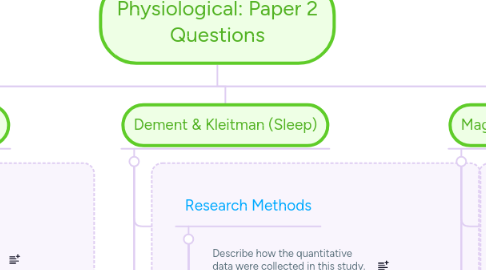
1. Physiological Approach
1.1. Outline
1.1.1. What is meant by a physiological test? [2]
1.1.2. Outline what is meant by the term ‘physiological psychology’. [2]
1.2. Evaluation
1.2.1. What are the advantages of investigating physiological processes? [9]
1.2.2. What problems may psychologists have when they investigate the physiological approach? [9]
2. Schachter & Singer (Emotions)
2.1. Research Methods
2.1.1. Describe how the data were collected in this study. [3]
2.1.2. Describe one control used by Schachter and Singer in their study. [3]
2.1.3. Describe the physiological processes investigated in this study. [3]
2.2. Alternative Study
2.3. Issues & Debates
2.3.1. Discuss the strengths and weaknesses of making generalisations from the study by Schachter and Singer. [10]
2.3.2. Discuss the extent to which the conclusions reached by Schachter and Singer are reductionist. [10]
2.3.3. Describe an ethical issue raised in this study. [3]
3. Dement & Kleitman (Sleep)
3.1. Research Methods
3.1.1. Describe how the quantitative data were collected in this study. [3]
3.1.2. Describe the qualitative data in this study. [3]
3.1.3. Describe the quantitative and/or qualitative data in this study. [3]
3.1.4. Describe how the data were collected in this study. [3]
3.1.5. Describe the physiological processes investigated in this study. [3]
3.2. Alternative Study
3.3. Issues & Debates
3.3.1. Compare and contrast qualitative and quantitative data using the Dement and Kleitman study as an example. [10]
3.3.2. Discuss the extent to which the study by Dement and Kleitman is reductionist. [10]
4. Maguire (Taxi Drivers)
4.1. Research Methods
4.1.1. Describe one control in the physiological tests used in Maguire et al’s study. [3]
4.1.2. Describe how the data were collected in this study. [3]
4.1.3. Explain why Maguire et al’s study is an example of the physiological approach. [3]
4.1.4. Compare and contrast the physiological testing approach as used by Maguire et al with other ways of gathering data. [10]
4.2. Alternative Study
4.3. Issues & Debates
4.3.1. Discuss the strengths and weaknesses of the physiological approach as used in the study by Maguire et al. [10]
4.3.2. Discuss the extent to which the findings of Maguire et al’s study can be usefully applied. [10]
4.3.3. Describe what this study tells us about the importance of nurture to development. [3]
4.3.4. Describe a generalisation that can be made from this study. [3]
5. Demattè (Olfactory Cues)
5.1. Research Methods
5.1.1. Describe how the data were collected in this study. [3]
5.1.2. Describe the physiological processes investigated in this study. [3]
5.2. Alternative Study
5.2.1. Design an alternative study to the Demattè et al study using a field experiment and describe how it could be conducted. [10]
5.2.1.1. Evaluate this alternative way of studying smells and facial attractiveness in practical terms rather than ethical terms. [10]
5.3. Issues & Debates
5.3.1. To what extent are the findings of Demattè, Ősterbauer and Spence generalisible? [3]
5.3.2. ‘Halo dumping’ was one possible threat to validity considered by Demattè, Ősterbauer and Spence. Discuss the validity of this study. [10]
5.3.3. Discuss the practical and ethical issues raised by the briefing questions in this study. [10]
5.3.4. Describe how this study is low in ecological validity. [3]
